
We had our flight booked to Santiago de Compostela for late April. Our plans for this year were to sail down the Portuguese coast and around the corner to the Algarve. Calypso was booked into the Sopramar yard at Lagos in early August, when we would fly home for the marriage of Alice, our daughter, and James.
Before that we had our 30th anniversary to celebrate and had a cottage booked on the harbour front at Porthmadog with Chris and Barbara (with whom we shared our wedding day in Antigua) and an anniversary lunch at the Portmeirion Hotel.
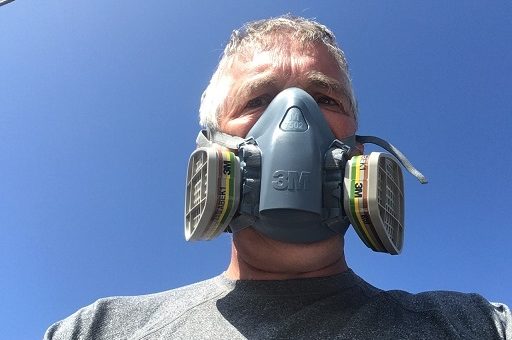
But in February we saw the contagion, only briefly mentioned a few weeks ago, grow. We decided that if we were to travel on an airplane we would wear high quality masks and not worry about what people might say – and so acquired these. They filter out chlorine and ammonia among other things, so surely a virus should not worry us on board?
Who knew that the world was about to be turned upon its head. Our wedding anniversary weekend was cancelled, the flights were cancelled, our sailing was cancelled, the wedding postponed and Paul’s 60th birthday country house cancelled.
Like everyone else we battened down the hatches and did our part. And unlike some our family has managed to come through unscathed. And so we didn’t complain that a year of our travels was lost. Instead, we just counted ourselves lucky.
As the summer progressed and things got a little less scary Val worked out how we could very cheaply convert the Berlingo “boat van” into a micro camper to allow us to visit Calypso without having to stay in hotels en route and without having to pitch a tent. We acquired a new caravan mattress, a second-hand roof box, some shallow storage boxes (to sit beneath the mattress) and silver sunshades to act as blinds. We also acquired a small pop-up toilet tent and a commode for the use of the “Disposa Johns” (Google it – we used these before installing the holding tank in Calypso).
Before setting off we had a couple of trial runs in North Yorkshire, one wild camp and one camp site stay, shown here.
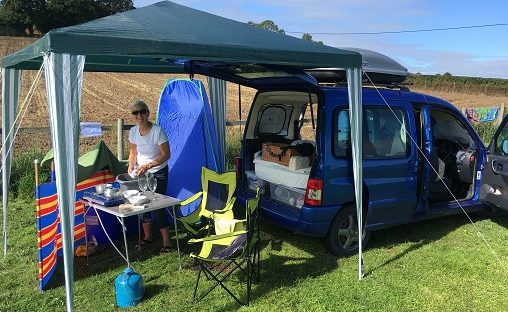
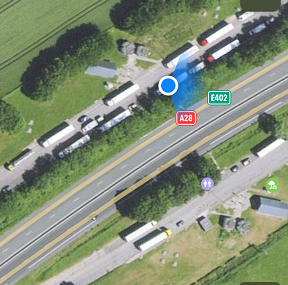
So in September we booked our ferry, the short crossing from Dover to Calais (ending in Dunkirk as Calais was on strike!) We decided to drive down the long way rather than risk an overnight ferry and end up poorly in a foreign country. So, it took us 4 days to drive from Yorkshire to Xufre. On the way we stopped in service areas. Very basic but just somewhere to put our head down. The most basic was our first night in France in a motorway wagon stop – parked at the blue dot and hemmed in by juggernauts!
We stopped for a walk along the sea front in San Sebastien where the weather was grey and damp, however by the time we reached Xufre we had sun and blue skies
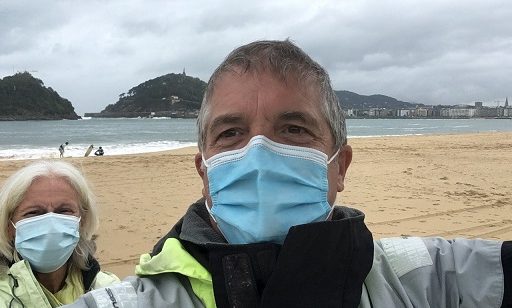
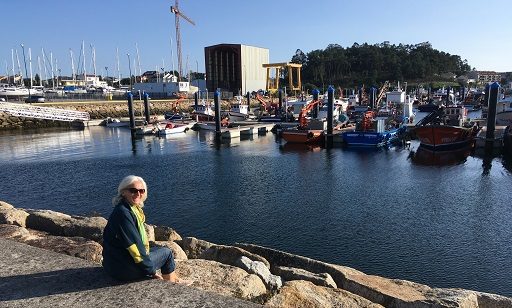
Whilst in the yard we stayed in the back of the Berlingo, given that the contents of the boat were strewn around in an attempt to allow air circulation.
We reconnected and recharged batteries, emptied and refilled the dehumidifier crystals (the buckets were full) and adjusted the coach roof cover. Alex had sent someone on board earlier in the year to check the cover had remained secure, and it had obviously performed well.

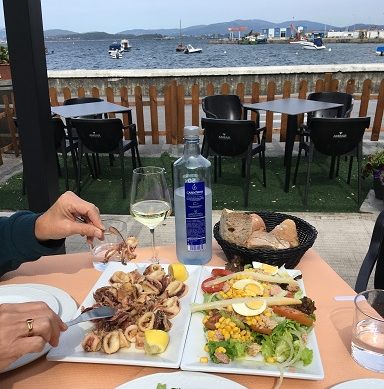
Whilst there we took the opportunity to remind ourselves of some of the delights of the bars and restaurants of Galicia – cold Estrella Galicia and excellent seafood. The weather was kind enough to allow us to sit outside and feel safe. Covid numbers were very low in Galicia and we were happy enough to enter supermarkets.
We also rewarded Bo and Beker for faithfully protecting Calypso for the last year.
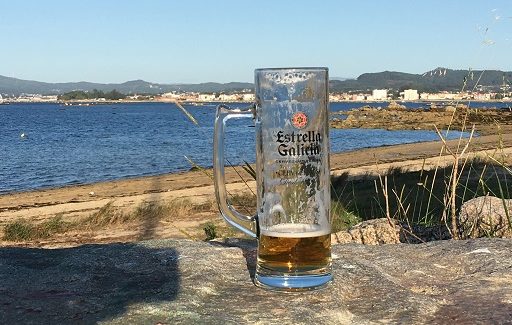
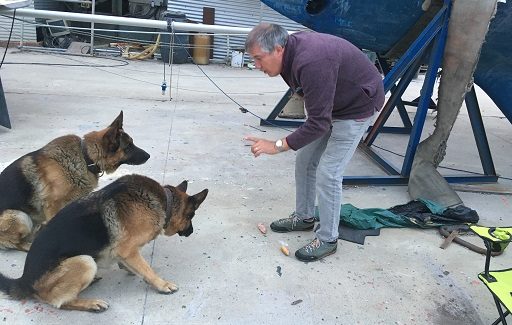
We only stayed at Xufre for 3 nights. There was only so much we could do and only so much calamares we could eat! We had arranged to visit our friends Rick and Debbie in a villa on the Algarve – where Covid numbers were also remarkably low and the villa was spacious enough so we had separate facilities.

On the way down we picked the shrine of Fatima as our overnight stop. This is a major destination for Catholic pilgrims and has a huge car park (we had been before). Camper vans are welcome in the car park, whereas we had heard that the Portuguese police were clamping down vigorously against wild camping.
In the vast square in front of the church sits the shrine itself, adjacent to the oak tree where Fatima’s miracle occurred. The small chapel inside the shrine is surrounded by a marble causeway, where penitents and those seeking a miracle cure walk circuits on their knees.
On the white walkway down the square you can just see a man walking on his knees, carrying his infant daughter in his arms. It was quite emotional to watch, but on reflection we hoped that perhaps he was asking for a long and fruitful life for his child.
The next day we arrived at the villa of friends Rick and Debbie just outside Lagos on the Algarve. We had invited ourselves for a few days’ stay, including Paul’s 60th birthday, and as always Rick and Debbie put on a brave face and a warm welcome.
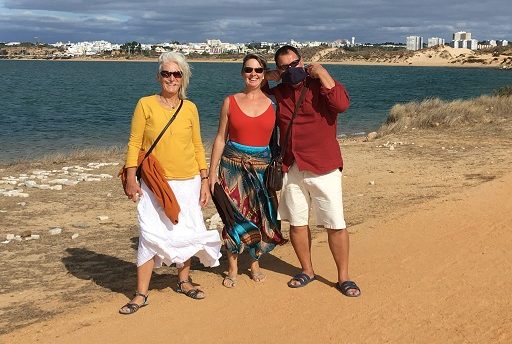
We stayed for 6 nights and enjoyed a few trips around the area. Paul demanded a pool party for his 60th birthday, and whilst the cover was rolled back Paul was the only one to brave the slightly chilly water – and demonstrated that age is not a barrier to immature foolishness. Rick fired up his BBQ/smoker and prepared possibly the best steak we have ever had – a marinated, smoked and reverse seared tomahawk steak, cooked perfectly. WOW!
There were a few old olive trees in the garden and Paul spent one afternoon up a pair of very tall stepladders picking olives – almost filling two 5L water bottles. These were washed and sorted and a 10% brine solution added – in which they would ferment in the Berlingo for the rest of the trip (fortunately we remembered to keep releasing the pressure.)


Our week with R&D came to an end and we plotted a route to the Bilbao ferry via a couple of cities and more remote campsites in Spain.
Our first stop was Ayamonte, just over the border from the Algarve on the coast. We had previously visited the marina here on Rick and Debbie’s yacht and knew there was a campervan park next to the marina. We planned to stay a couple of nights but the usually buzzing town centre was quiet, and the mosquitos in the town were clearly very hungry, we were bitten to distraction!
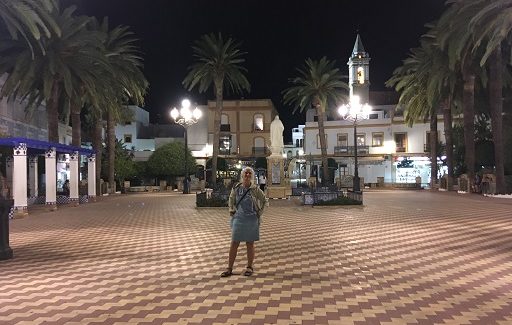

Next came a flying visit to Cordoba. We were to camp north of the city but called in to wander around the old central area with impressive old Catholic and Moorish buildings. Again it was quiet but we did get surrounded by “super-spreaders” suddenly gushing out of school into a narrow back-street and beat a hasty retreat.
This was certainly a scouting visit for a future trip in more relaxed times, but after a couple of hours we headed to our campsite on the outskirts – complete with unheated swimming pool. We braced ourselves and took the plunge. It has to be said that Spanish campsites are almost without exception (in the several we have experienced) superb, with excellent facilities and spotlessly clean.
When we arrived we read a message from the Xufre yard to say that our AIS was transmitting. How could that be, Paul had removed the terminals from the battery that carried current away – or so he thought. And so we changed plans from a visit to Toledo to go farther North to the site at Tordesillas, from which we would travel to Calypso, spend a night there sorting the problem and drive back to Tordesillas.
The detour back to the boat added 580 miles over the next two days. It turned out that the AIS connection sits at the far side of the battery bank, not in clear site, and Paul had lazily just removed the connections at the near side. We were grateful to Xufre for contacting us as that would otherwise have run the house batteries down and probably destroyed them. Lesson learned with a 580 mile round trip, but better than a £1,000 replacement bill!
Arriving back at small town Tordesillas the next day we wandered from the campsite the short distance across the river to the historic old centre. In the main square we had the coldest beer ever – it was actually freezing in the glass! We quickly forgot the long and unnecessary trip in hot weather with no air conditioning…..

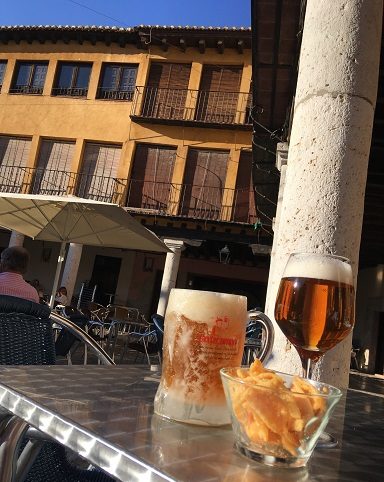

The following day we decamped really early to get back on track. After a short distance we pulled off the motorway for breakfast and happened across a small chapel in a very quiet spot. As we enjoyed our breakfast on the bench at the side of the chapel the peace was interrupted by a car driven at high speed around the chapel onto a side street and off on the dirt track.
5 minutes later a Police car followed. They pulled up and gabbled Spanish at machine gun pace. Paul assumed he knew what they wanted. He pointed to the dirt track, and with three words – “azul coche, rapido” the chase was back on…………………..
A short time later we arrived in Valladolid, which turned out to be our favourite visit. The town seemed a little more lively (in a Covid secure way). In addition to the central square we visited a couple of large church/cathedrals of the usual colossal proportions and housing fantastic religious art.
We also visited the modern art gallery and benefitted from a virtually private tour of the exhibition spaces. A good variety of modern art, some of which we really liked (with the usual less inspiring exhibitions to pass quickly through).
In a very atmospheric old delicatessen/bodega we bought a few things and ended up almost exhausting Paul’s Spanish vocabulary in conversation with the lovely old owner and his assistant. After paying and as we left we received a present of assorted artisanal cured meats. We find the Spanish peoples soooo welcoming.

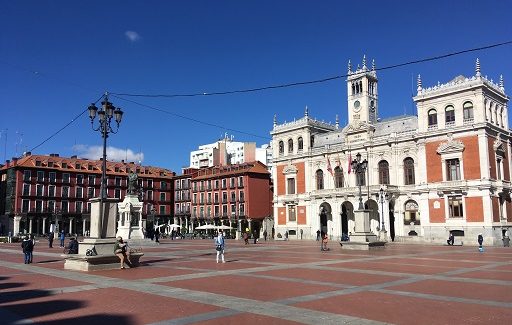
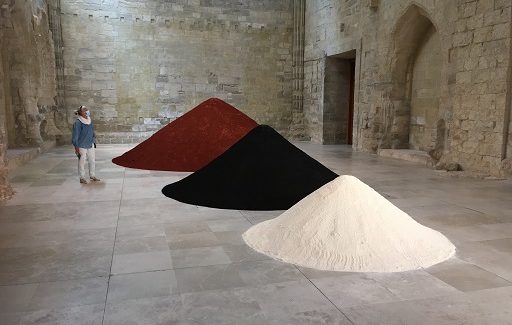
Moving swiftly on (Rioja and wine tasting beckons….) we headed off the beaten track, passing more small farming communities towards the next campsite at Castrojeriz, arriving mid afternoon at a fantastic little campsite. No campsite but other facilities and location were excellent.

The site sits beneath a large pimple of a steep hill, atop of which sits yet another castle. After settling in we climbed through the village (see top photo) to the castle, the views from which were spectacular. A couple left as we arrived and left us to explore the ramparts on our own. We could see for miles, and looking back down on the village our campsite is in the wooded area, right of centre.
We rejuvenated tired legs with a beer in the small campsite bar (chatting laboriously but happily to the owners) and a BBQ and retired for the night.


Next stop was the campsite at Haro, within a stroll of several major Rioja Bodegas in the Estacion area, Muga being our favourite.
We planned 2 nights here but rather than filling it with wine tasting we included a day of sightseeing around the beautiful Rioja Alta area.
In Najera we paid to visit the fascinating Santa Maria La Real Monastery attached to a church built from 1052 at the entrance of a cave where an image of the Virgin was discovered. This is a small town built on the bank of a river over which stands a long cliff within which can be seen troglodyte caves. Spain is just endlessly fascinating!


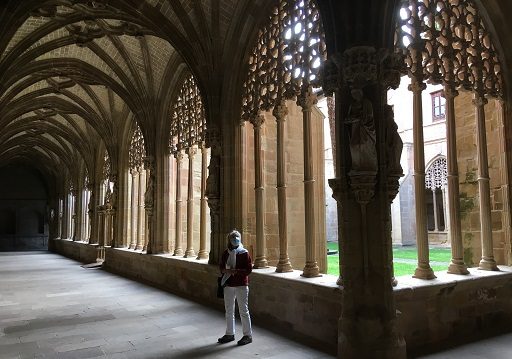
We had a ferry to catch in the afternoon, but on our last day had arranged to visit Maite at the Abel Mendoza vineyard. We had stumbled across them on our way home last year and now returned with an order for ourselves and friends at home. It was lovely to see Maite again and a good end to our 22 night trip – 16 of which we had slept (very comfortably) in the back of the Berlingo, Val’s inspired idea having worked very well.
And we returned home in the expectation of a difficult winter ahead, uncertain of when we might be back but still thankful that our friends and family have remained unharmed by the Covid 19 virus. Compared to many we have nothing to complain about.
